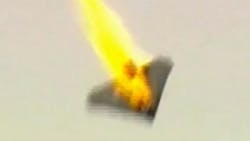Army considers counter-UAV weapons; surveys industry for promising enabling technologies
REDSTONE ARSENAL, Ala., 6 March 2014. U.S. Army aerial warfare experts are turning their attention to the threats of enemy attack and reconnaissance unmanned aerial vehicles (UAVs), and how to counter potentially hostile unmanned aircraft.
With this in mind, officials of the Army Aviation and Missile Research, Development, and Engineering Center (AMRDEC) at Redstone Arsenal, Ala., are attempting to assess capabilities in the U.S. defense industry to develop enabling technologies for counter-UAV operations.
Among the Army's primary counter-UAV research projects today, for example, is the High Energy Laser Mobile Demonstrator (HEL MD) -- a joint project of the Army and the Boeing Co. Directed Energy Systems segment in St. Louis -- which is a truck-mounted laser weapon intended to shoot down enemy UAVs, rockets, artillery rounds, and mortars.
Related: Boeing high energy laser system continues to high-power testing
AMRDEC officials have issued a request for information (W31P4Q-14-R-0086) for the Counter Unmanned Aerial System Capability program to conduct market research that could help develop an affordable counter-unmanned aerial system (CUAS) system.
From industry, Army researchers are trying to determine if current and near-term emerging technologies could support a counter-UAV capability; identify feasible counter-UAV system concepts; and estimate costs and performance.
U.S. warfighters face threats now and in the future from reconnaissance and armed UAVs ranging from micro-sized to large UAV that operate with varying altitudes and speeds, Army officials point out.
Appropriate counter-UAV enabling technologies should take into account all levels of detection, decision, and defeat. The Army's primary counter-UAV concerns today involve command echelons at brigade and higher, as well as below the brigade -- or the tactical edge -- officials say.
Counter-UAV concepts should consider tactical networking between above-brigade and below-brigade command levels, officials say. Network connectivity can help detect and classify potential threats, as well as coordinate ground- and air-based countermeasures.
Companies interested should mail 10-page white papers no later than 1 April 2014 to U.S. Army RDECOM, Building 5400, Fowler Road, ATTN: RDMR-WDP-I / Mr. Steve Bramlett, Redstone Arsenal, AL, 35898-5000.
For questions or concerns phone the Army's Miroslaw Chodaba, 256-876-2105. More information is online at https://www.fbo.gov/notices/94d4624458cac9978a69abc1ff6ccbd3.

